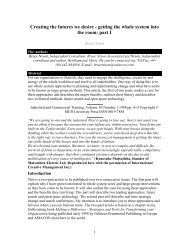From Old Economics to New Economics- Radical ... - Bruce Nixon
From Old Economics to New Economics- Radical ... - Bruce Nixon
From Old Economics to New Economics- Radical ... - Bruce Nixon
Create successful ePaper yourself
Turn your PDF publications into a flip-book with our unique Google optimized e-Paper software.
Standard, neoclassical economics strains out the gnats of allocative inefficiency while swallowing the<br />
twin camels of unjust distribution and unsustainable scale. 19<br />
The ‘new economics’ that underpins our vision of the economy of the future draws upon the<br />
work of these thinkers, but also incorporates other traditions within what is commonly called<br />
‘heterodox economics’. 20<br />
5.3. Heterodox economics<br />
An interested question <strong>to</strong> pose is the following: given that it is increasingly clear that our<br />
lifestyles a) do not make us happy, b) create and maintain huge social inequalities and c) are<br />
leading us <strong>to</strong> environmental disaster, why do we persist in following the same, well-worn<br />
path<br />
<strong>From</strong> a neoclassical perspective, the answer is straightforward: our behaviour is that which<br />
maximises our individual utility, given our set of preferences and within a particular budget<br />
constraint. That is, we choose <strong>to</strong> act as we do because we want <strong>to</strong>.<br />
<strong>From</strong> the earliest days, however, critics have pointed out some major problems with this<br />
framework. One such critique is the idea that individual preferences – i.e. what people want –<br />
are both ‘fixed’ (in that they do not change over time) and ‘exogenous’ (in that they simply<br />
arrive fully formed).<br />
At the turn of the 20 th Century, an important critic of this view of decision-making was<br />
Thorstein Veblen, who was one of the origina<strong>to</strong>rs of ‘institutional economics’. Veblen argued<br />
that individuals did not take decisions by objectively assessing the relative utility that would<br />
result from each in terms of their own fixed preferences. Rather he stressed the importance of<br />
‘institutions’ – defined broadly as “enduring systems of socially ingrained rules 21 ” – in<br />
shaping these decisions.<br />
It has long been accepted that:<br />
All processes of rational decision-making depend on acquired cognitive frames for the selection,<br />
prioritization, interpretation and understanding of the huge volume of sensory stimuli that reaches the<br />
human brain. 22<br />
Furthermore, these ‘cognitive frames’ or ‘rules’ must be learned in a social context. Thus<br />
‘preferences’ in this sense are indeed partly learned and culturally specific. To some extent<br />
this describes the process of the ‘socialisation’ of children, but an institutionalist would argue<br />
that this is certainly not the end of the s<strong>to</strong>ry. Veblen argued that institutions shape preferences<br />
throughout life: ‘wants and desires’ are therefore not fixed but malleable, and a key driver is<br />
the transformation of habit in<strong>to</strong> preference.<br />
Hodgson (2000) describes the role of institutions in this respect as follows:<br />
They channel and constrain behavior so that individuals form new habits as a result. People do not<br />
develop new preferences, wants or purposes simply because “values” or “social forces” control them.<br />
Instead, the framing, shifting and constraining capacities of social institutions give rise <strong>to</strong> new<br />
perceptions and dispositions within individuals. Upon new habits of thought and behavior, new<br />
19 Daly (2003)<br />
20 ‘Heterodox economics’ is simply that which is not ‘orthodox’ (i.e. neoclassical) economics.<br />
21 Hodgson (2000)<br />
22 Ibid.<br />
27



